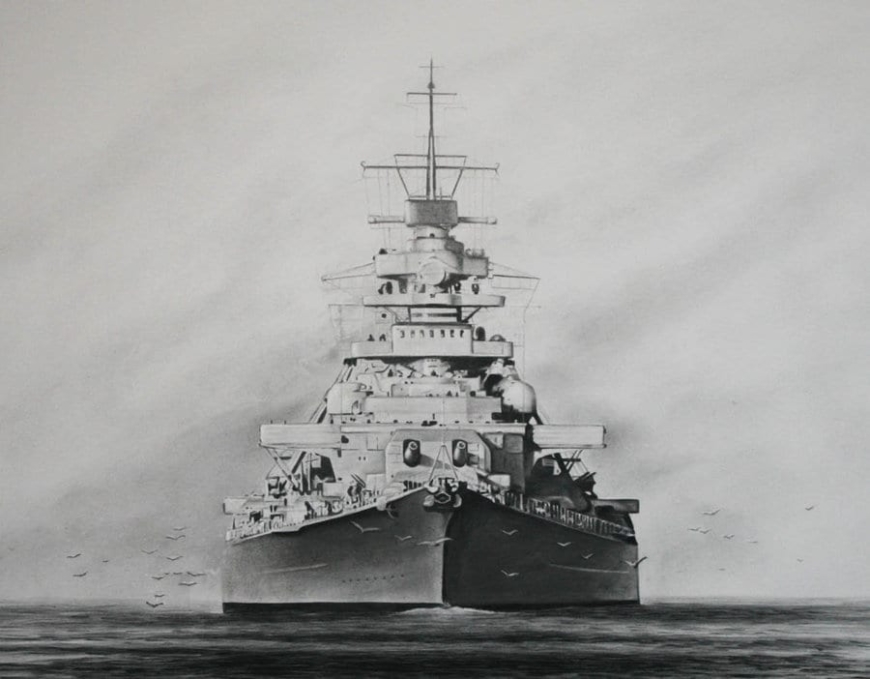When West first learned about Bismarck, the latest German battleship, they were shocked. Faced with the shortage of steel and other war materials, German’s Kriegsmarine was forced to make several compromises in terms of tonnage. When it was launched, Bismarck and her sister ship Tirpitz were among the largest battleships ever constructed by a European navy, standing at 41,000 tons. The latest Royal Navy’s battleships of King George V class were slightly bigger than Bismarck, but two knots slower.

German ship had other advantages, though. First were its excellent guns. German preferred 380 mm guns, compared to 360 mm and even 406 mm other navies used. Although the shell was smaller and thus inflicted less damage on its target, the rate of fire was faster, leading to quicker fire correction and more hits. Krupp’s guns were already renowned for their accuracy and aided with a fast rate of fire, German gunners were able to land considerably more hits than their opponents, more than enough to compensate for lesser damage caused by a single shell.
Another important advantage was Bismarck’s speed. Able to develop 30 knots, it could easily outrun British warships which topped out at 25 knots. This allowed Germans to dictate the terms of engagement and decline to fight if found themselves outnumbered or outgunned.
Brits soon realized that they had very few ships that could go one on one with Bismarck and hope to survive, not to mention win. This fact was confirmed when Bismarck encountered Hood in the North Sea in 1942. The venerable battle cruiser was once a pride of the Royal Navy. At 47,000 tons, it dwarfed a majority of battleships of the era. Its huge 15-inch (360 mm) guns could easily destroy any target that dared to challenge her. However, despite the recent modernization, Hood was a 20-years old design and its age was showing. Unfortunately for the crew, it suffered from the same flaw that doomed British battlecruisers at the battle of Jutland, when two of them were sunk by a single hit each into the midsections, which penetrated their armor and exploded in ammo storage. The resulting explosions sent both to the bottom.
The same fate awaited Hood. Out of 1438 souls on board, only three survived and Bismarck sailed into the Atlantic, only to meet its doom four days later in North Atlantic. It took almost the entire might of the Royal Navy, enraged by the loss of Hood, to hunt it and finally sink it west of 650 km west of French port of Brest. Bismarck wreck was found in 1989, at a depth of 15,000 feet (almost 5 km).

One of the ships that could easily match Bismarck both in terms of gunnery and speed was designed, USS Montana. Intended as a replacement for Iowa class battleships, Montana class was to have five ships BB-67 through BB-71). The proposed behemoth was rated at 60,000 tons (70,000 fully loaded) and armed with 12 monstrous 16-inch (406 mm) guns. Same like Iowa class, Montana’s guns were to be radar controlled, allowing excellent precision no other ship outside United States Navy could match at the time. With a crew of 2,355, this fortress on water could develop a speed of 28 knots, allowing it to easily catch her prey in open waters. Its armor was 22.5 inches (572 mm) thick at places, and only the largest armor-piercing shells could have any hope of penetrating it and inflicting some damage. Anything smaller, and Montana would shrug it off, with nothing but scratched paint. Montana-class was canceled in favor of more Essex-class carriers, as United States Navy realized that the future of naval warfare lies with carriers and not battleships.
If Bismarck and Montana ever met in an engagement, the result would be largely one-sided. The advantage in gunnery, speed, and armor meant that Montana would be able to open fire from a greater distance. Aided by radar, its guns would be so precise that Bismarck probably wouldn’t have a chance of even firing her main armament before Montana’s shells start to land on deck. Even if Bismarck by some miracle managed to land a hit on Montana, the chances are that it would take far more than that to knock it out of action. In the end, the technology gap was just too wide for Bismarck to have any chance against Montana.
Source: nationalinterest.org




